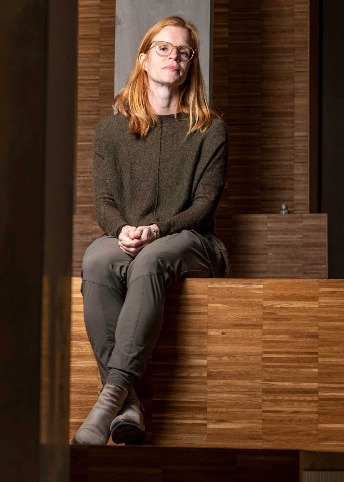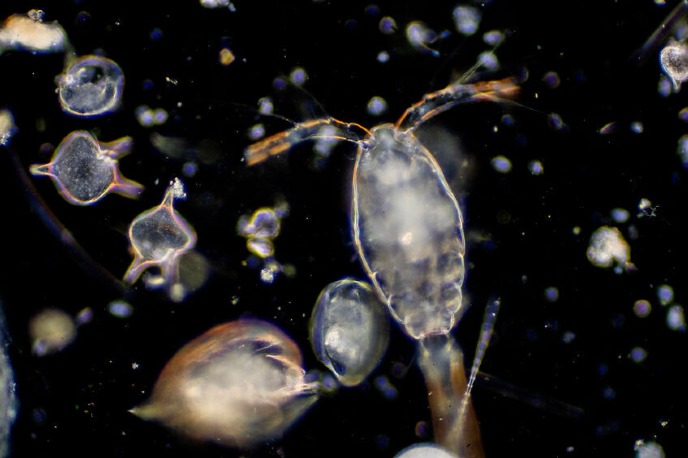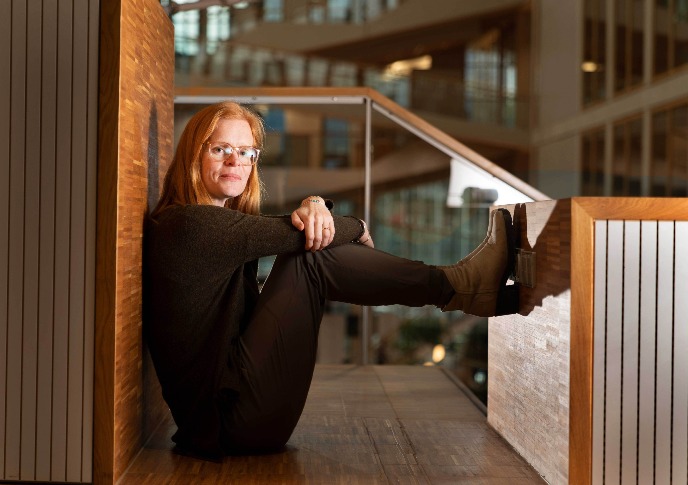Glue for the lungs

How is it possible that a gecko can hang from the ceiling? And why is a mussel able to stick so well under water? Nature’s mysteries are a source of inspiration for researcher Marleen Kamperman. She wants to make and market new materials. It may very well be possible in the near future that a doctor can ‘seal’ a damaged piece of lung.
Text: Merel Weijer, Corporate Communication UG / Photos: Reyer Boxem
The various forms of adhesion in nature were a starting point for Kamperman’s research on polymers and their biomedical applications. As the Science Director of HTRIC (Health Technology Research and Innovation Cluster), a flagship programme from the University of the North, she is also committed to bringing research and its application together. She works together with Dirk Jan Slebos on a glue that hardens inside the body and, because of this characteristic, is able to ‘seal’ the damaged lungs of patients with severe COPD.
Shapes in nature
Kamperman worked as a PhD student in the United States on nanocomposite materials: particles to make catalysts suitable for processes that take place at very high temperatures. That is when she developed her interest in creating materials that are based on natural systems. ‘If you look at plankton under the microscope, you see the most beautiful shapes because their skeleton is on the outside. We tried to copy the way in which these shapes are formed for these catalysts.’ She has been interested in materials and structures in nature ever since. Even in her spare time she loves to read about, for example, how giraffes get their markings.

Glue inside the body
Since being awarded her PhD, Kamperman has studied adhesion in nature. How, for example, do a gecko’s legs stick to the ceiling? How can you cleverly replicate that? And how does this work on wet surfaces, such as for mussels and sandcastle worms? The glues that she is now creating for biomedical applications are all inspired by these natural phenomena. What did she notice with mussels? If the glue is secreted under water, it is still a liquid. It then hardens, just like superglue. The difference is that superglue hardens as a result of a chemical reaction, whereas natural glues often harden as a result of a change in the environment, such as salt concentration or temperature. Kamperman: ‘We now also use that insight. For example, a glue that is injected into your body is liquid at first, but because it is warmer inside your body it will automatically turn into a solid.’
Helping patients
This knowledge now benefits a project that she is working on together with lung specialist Dirk Jan Slebos, who works with patients who have severe COPD and who are barely able to climb the stairs. The damage to the lungs is so extensive that a lung transplant is often the only solution. A procedure that is often too strenuous for these patients and, of course, there are only a limited number of donor lungs. Kamperman: ‘What we actually want is to seal a piece of the lung. We are now optimizing glue exactly for that purpose.’ This glue in the lungs must not dissolve, as it does with skin transplants, but must stay there for ever. Research and marketing the product require quite a bit of coordination in this case. That is where an organization such as HTRIC may be able to help.
HTRIC and the University of the North
Kamperman has been involved with HTRIC for a year now. It was founded to improve the collaboration between the Faculty of Science and Engineering (FSE) and the UMCG and to encourage the development of medical technologies. Furthermore, HTRIC is committed to better collaboration with universities of applied sciences and industry. It is not surprising that the programme operates under the name of University of the North. ‘I am fully behind the University of the North’s goals,’ says Kamperman, for whom the proximity of the UMCG was a reason to start working in Groningen.
Design Thinking for students
HTRIC tries to shape its goals in various ways. For example, a degree programme manager is working on better collaboration for course units at the interface of the various educational institutions. Kamperman is also of the opinion that the way of thinking about what you can do after your PhD studies should change. ‘I think that it would be logical to better prepare PhD students and to also involve industry. Offer them a course in Design Thinking or Entrepreneurship, for example.’

The circle is closed
Kamperman, who studied chemistry in Groningen, was uncertain for a long time about how to continue her career: in industry or in science. In the end, she chose to follow a PhD programme in the US. ‘I think that it is good for students to realize that there is more than research and that research is not always the pinnacle. However, that is now also ambiguous for me because I want to keep the best students here as PhD students, of course.’ Ultimately, Kamperman returned to Groningen. The office where she is now, is the office of the professor who supervised her graduation all those years ago. That means that the circle is now closed.
Questions from clinical practice or industry
Researchers also have many opportunities to collaborate. For example, four PhD students within HTRIC are conducting research on the interface of the UMCG and the FSE. Preferably with a question from clinical practice or from industry as a starting point. Kamperman: ‘We want to encourage that, getting genuine clinical questions and working with them. That industry will also see: hey, there is a possibility of a great collaboration.’
Practical problems
It is not easy to establish such a collaboration. Kamperman has had that experience herself. She creates glues with a medical application, including skin transplants for burn injuries. But before such a product is available on the market, many questions need to be answered. Do you perhaps want to sell your technology? And if so, to whom? Are you going to do that through your own company? How will you get money? What are the medical regulations? HTRIC likes to help researchers who have such questions, for example by making sure that the researcher can employ someone who can help with regulations. Or by setting up a fund to start their own company.
With great expectations...
Kamperman now also has to solve these types of practical questions herself. She has to think about what is toxic and what is permissible, for example. Or testing the glue on pig lungs from the abattoir. All of this is closely followed by Dirk Jan Slebos, who can hardly wait until he can use the glue. Kamperman is already looking forward to that moment. That is what she is ultimately doing all this for.
About the University of the North
The University of the North (UvhN) is a knowledge and innovation network comprising five northern knowledge institutions: the University of Groningen, Hanze University of Applied Sciences, Van Hall Larenstein University of Applied Sciences, NHL Stenden University of Applied Sciences, and the University Medical Center Groningen. The initiatives that they take together demonstrate the impact of education, research, and innovation on society. The UvhN aims to achieve widespread prosperity and to serve as an inspiration for the rest of the Netherlands. The first extraordinary results of the UvhN’s flagship programmes are already visible. One of those is HTRIC–the Health Technology Research & Innovation Cluster.
More information
| Last modified: | 15 February 2023 4.21 p.m. |
More news
-
29 April 2024
Tactile sensors
Every two weeks, UG Makers puts the spotlight on a researcher who has created something tangible, ranging from homemade measuring equipment for academic research to small or larger products that can change our daily lives. That is how UG...
-
29 April 2024
Behind the scenes: how UG and Hanze UAS students are jointly developing a Mars rover
This year the students of the Makercie team are participating in the physical edition of the European Rover Challenge in Poland. Read more about the team and the collaboration between the RUG and Hanze UAS here.
-
23 April 2024
Nine MSCA Doctoral Network grants for FSE researchers
Nine researchers of the Faculty of Science and Engineering have received a Horizon Europe Marie Sklodowska Curie Doctoral Network grant.
